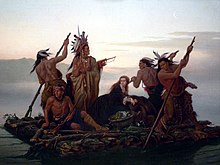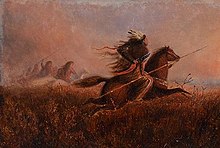Charles Wimar

Charles "Carl" Wimar (born February 20, 1828 in Siegburg as Karl Ferdinand Weimer , † November 28, 1862 in St. Louis , Missouri ) was a German-American painter from the Düsseldorf School .
Life
Charles Wimar emigrated to the USA with his family in 1843 at the age of 15 and settled in St. Louis, then a border town and center of the American fur trade. After an apprenticeship with a house and ship painter, he studied painting from 1846 to 1850 under the guidance of Leon Pomarede . In 1850 he opened a studio in St. Louis. An inheritance allowed him in 1852, Dusseldorf to go to art study. Wimar received private lessons from Joseph Fay and Emanuel Leutze , the latter, like himself, a German-American . Wimar made 23 paintings in Düsseldorf alone, especially depictions of conflicts between American settlers and Indians, which were exhibited with great success in Elberfeld, Hanover, Cologne and St. Louis. In order to be able to depict the Indians as faithfully as possible, he had his parents send him their clothing and utensils from Missouri. In 1853 he created the first version of the painting The Abduction of Daniel Boone's Daughter by Indians , in which he processed an event from 1776. In 1855 he repeated the motif. In September 1854 Wimar moved into a studio in Oswald Achenbach's house , where Worthington Whittredge , Henry Lewis , Joseph Fay and Emanuel Leutze also worked. As a member of the artists' association Malkasten , Wimar was involved in the social life of Düsseldorf painters. In a local artist production of the “Operagout” Pannemann's Traum , he played the national allegory America . According to a report by Henry Lewis, he also performed amusing Native American war dances on the paint box stage in Native American clothing and in possession of original Native American artifacts.
In 1856 he returned to St. Louis and undertook two expeditions along the Missouri River , the Mississippi River and the Yellowstone River in 1858 and 1859 , where he documented the settlement of the American West and its indigenous people in pictures. In the early 1860s, Wimar was commissioned to create murals for the rotunda of the St. Louis courthouse. Shortly after completing this work, he died of tuberculosis in 1862 .
His works are considered important exhibits in the City Art Museum in St. Louis. His oeuvre is particularly important because of the ethnographic interest in the Indians. Wimar is considered to be the forerunner of painters like Frederic Remington and Charles Schreyvogel , who also placed the life and landscapes of the Wild West at the center of their paintings.
Web links
literature
- Bettina Baumgärtel (Ed.): The Düsseldorf School of Painting and its International Impact 1819–1918 , Volume 1: pp. 18, 192, 193, 198, 199, 276, 279, 363, 364, 443; Volume 2: p. 333 f. (Catalog numbers 277, 278)
- Rick Stewart, Joseph D. Ketner II., Angela L. Miller: Carl Wimar. Chronicler of the Missouri River Frontier . Harry N. Abrams, New York 1991.
- Charles Vollan: Wimar, Charles . In: David J. Wishart (Ed.): Encyclopedia of the Great Plains . University of Nebraska Press, Lincoln / London 2004, p. 131 f. ( online )
Individual evidence
- ↑ See article Henry Lewis (artist) in the English language Wikipedia.
- ↑ Sabine Schroyen: "A true brotherhood seems to reign among them." - The artists' association Malkasten and its international members . In: Bettina Baumgärtel (Ed.): The Düsseldorf School of Painting and its International Radiance 1819–1918 , Volume 1, p. 276.
- ^ Sabine Morgen: The Effects of the Düsseldorf School of Painting on America in the 19th Century. Düsseldorf paintings in America and American painters in Düsseldorf . Göttingen Contributions to Art History, Volume 2, Edition Ruprecht, Göttingen 2008, ISBN 978-3-7675-3059-1 , p. 727.
- ^ Rudolf Cronau : Three centuries of the Germans in America . Berlin, 1909, reprint of the original edition: Europäische Hochschulverlag, Bremen 2013, ISBN 978-3-95507-920-8 , p. 537 ( online ).
| personal data | |
|---|---|
| SURNAME | Wimar, Charles |
| ALTERNATIVE NAMES | Wimar, Karl Ferdinand; Wimar, Carl |
| BRIEF DESCRIPTION | German-American painter |
| DATE OF BIRTH | February 20, 1828 |
| PLACE OF BIRTH | Siegburg |
| DATE OF DEATH | November 28, 1862 |
| Place of death | St. Louis , Missouri |



